What is Nachiket & Yama Deva story (conversation, dialogue) (full info) | What is the story of the Kathopanishad (Katha Upanishad)?
Namaste friends, how are you doing today? Welcome to #BhagavanBhakthi website / blog.
Bhagavan Lord Sri Krishna (Lakshmi Narasimha) (Vitthal) (Vishnu) (Rama) (Trivikrama) and Goddess Sri Rukmini (Lakshmi) blessings to you and your family!
In this website / blog, you will always learn about #Hinduism #Sanskrit language.
Also subscribe to my YouTube channel from this link #BhagavanBhakthi to view videos about #Hinduism #Sanskrit language.
Just before going to “What is Nachiket & Yama Deva story (conversation, dialogue) (full info) | What is the story of the Kathopanishad (Katha Upanishad)?“, let us know a brief, basic and very important information.
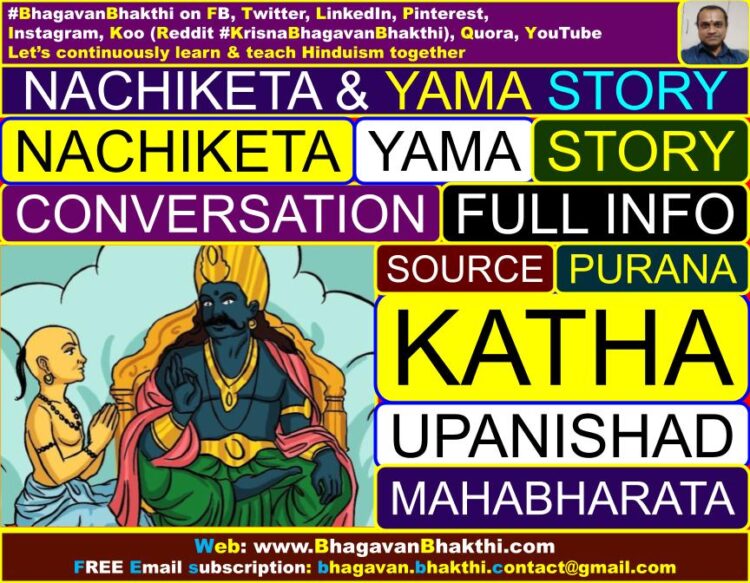
Nachiketa parents names are : Vājashravas (Vajasravasa) or Uddālaka (father) | In which Upanishad story of Nachiketa is told? : Katha Upanishad (कठोपनिषद्) (कठ उपनिषद्) (kaṭhōpaniṣad) (kaṭha upaniṣad) and Mahabharata.
Nachiketa name meaning : The meaning of the name Nachiket is that he is someone who is unconscious of his questions, i.e. he is unaware of the depth of the questions he asks.
Information about Nachiketa and Lord Yama story (conversation) (dialogue) is as given below (As per Katha Upanishad):
Lord Sri Vishnu avatar of Lord Vamana is the Brahma-vidya (secret knowledge) of this Katha Upanishad – the God known from its central theme. Lord Yama, the god of Dharma and Death, is the seer of these mantras. This knowledge was later received by the young boy Nachiketa.

Lord Vamana is the embodiment of all souls here and hereafter, controlling all activities at all times and in all places. And this Katha Upanishad is always great for anyone and everyone who specifically mentions these:
“मध्ये वामन वसीनं”, “विद्धि त्वमेतं निहितं गुहयं”, “ईशानो भूत भव्यस्य”, “परमप्नोति तद् विष्णोहो परमं पदम्” इत्यादि।
“ಮಧ್ಯೇ ವಾಮನ ವಾಸಿನಂ”, “ವಿದ್ಧಿ ತ್ವಮೇತಂ ನಿಹಿತಂ ಗುಹಯಂ”, “ಈಶಾನೋ ಭೂತ ಭವ್ಯಸ್ಯ”, “ಪರಮಾಪ್ನೋತಿ ತದ್ ವಿಷ್ಣೋಹೋ ಪರಮಂ ಪದಂ” ಇತ್ಯಾದಿ.
“Madhyē vāmana vāsinaṁ”, “vid’dhi tvamētaṁ nihitaṁ guhayaṁ”, “īśānō bhūta bhavyasya”, “paramāpnōti tad viṣṇōhō paramaṁ padaṁ” ityādi.
Sri Madhvacharya Ji, thus specially pays his salutations to the Lord Vishnu’s avatar of Lord Vamana at the beginning of his commentary (bhashya). There are many commentary and interpretations of the Katha Upanishads, traditional or otherwise, by famous scholars and intellectuals.
But the uniqueness of the Sri Madhvacharya’s commentary lies in allowing Lord (Sage) Sri Vedavyasa to speak for himself. Sri Madhwacharya keeps his words to a minimum levels and instead delights in projecting Lord (Sage) Sri Vedavyasa by quoting extensively from the Shrutis, Smritis, Sutras, Itihasas and Puranas.
Lord (Sage) Sri Vedavyasa, an incarnation of Lord Sri Vishnu, who could excel in teaching us the intricacies of the Hindu texts he imparted – in authority and clarity!
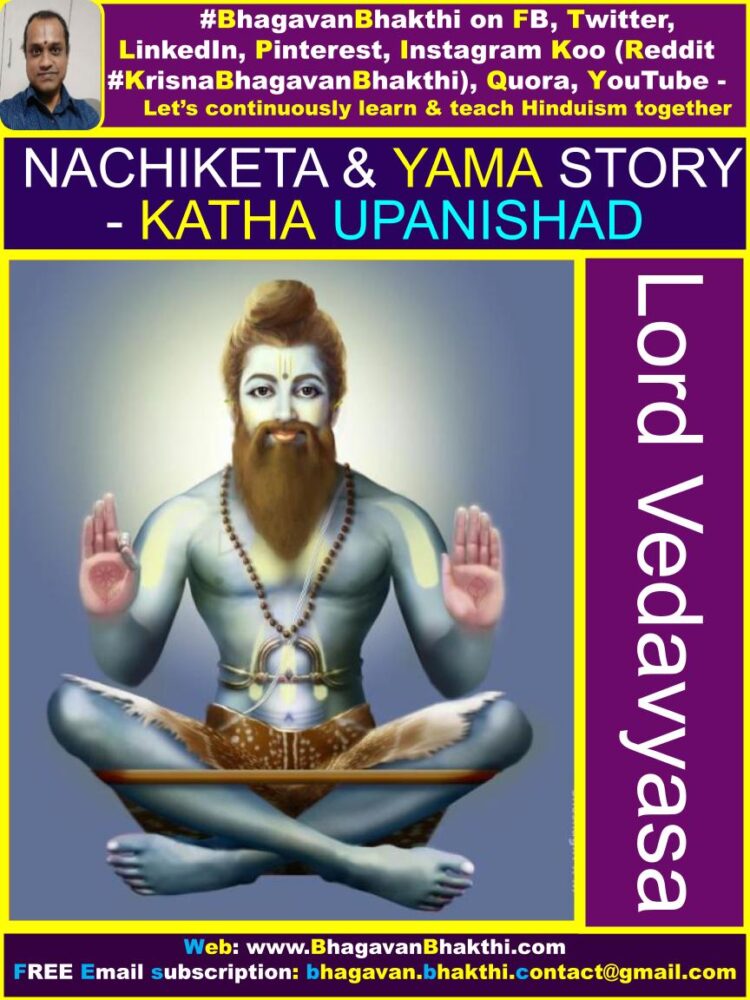
The story of Nachiketa and Lord Yama with 118 mantras in the Katha Upanishad is told more extensively in Krishna Yajurveda Kataka, Taitreeya Brahmana, Gatisara, Anushasana Parva of Mahabharata etc.
Sri Madhwacharya Ji mentions Brahmasara, Gatisara, Padma Purana, Brahmanda Purana, Brahma Vaivarta Purana, Maha Varaha Purana, Shabda Nirsha, Bhaivayat Parva, Kurma Purana etc.
An eight-year-old child Nachiketa exhibits such fearlessness towards death that it is worth learning and pondering. The Katha Upanishad explains it clearly with the message that once we know this truth many of our fears disappear and hence we die only to be born again.
It is significant to understand here that in the whole range of our scriptures, the wicked were always worried about death and tried their best to avoid it. Avoid death is to live forever is the way of thinking. He thought of the best possible boons.
But alas, they all had to die in one way or another without exception. At the same time, good souls like Nachiketa never feared death. He knew that death is inevitable after birth. So his thought was always away from birth instead of death.
Although both look for eternity, their methods are different. Moreover, the wicked sought it in this mortal world but the wise knew the secret. We can perhaps examine our attitude toward death, now and then, and prepare to face it instead of fearing it or conquering it.
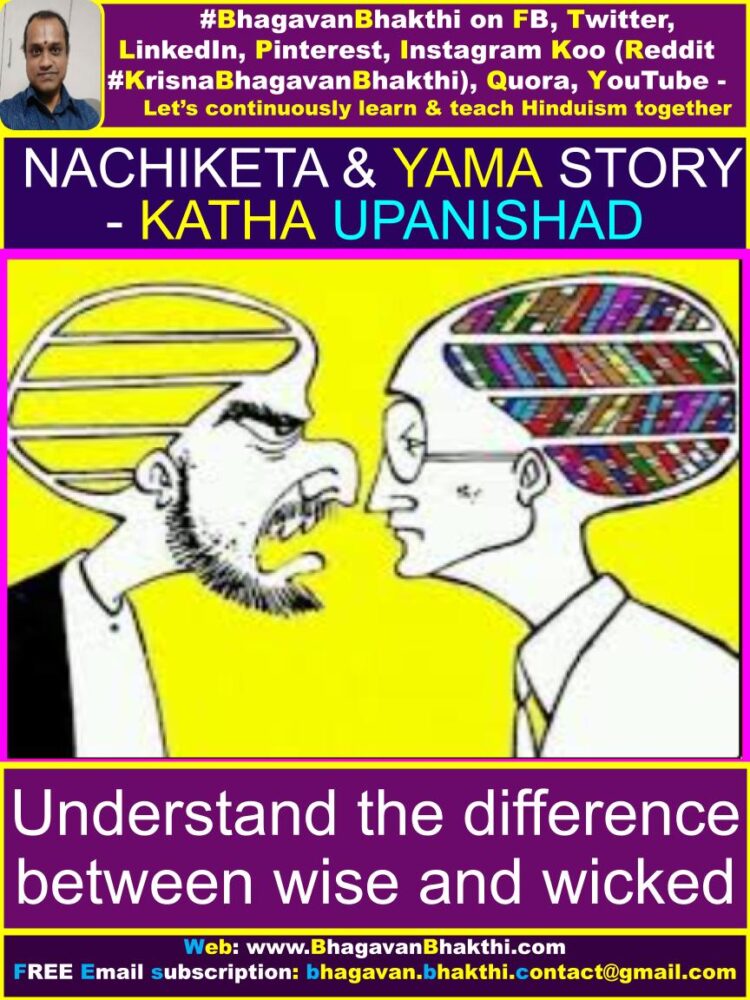
Nachiketa goes to Yamaloka as charity (daanam) (donation), mainly to learn two things: 1. The way to live life in this world as a Yajna (sacrifice) to Lord Sri Vishnu.
2. To know more and more about Parabrahman (Vishnu) as the controller (Niyamaka) of finally dead and liberated souls. Sri Madhvacharya Ji cites Brahmasara as saying that one who always thinks of Lord Sri Vishnu in Agni (Yajna or life) goes to Swarga Loka (Heaven).
Similarly those people stays there for Manvantara and then gets emancipated from there as part of the proper process. In order for Nachiketa to share his special knowledge with his father for his own use, Nachiketa asks Lord Yama for his father’s first boon of tranquility.
The three boons Nachikeya receives are interrelated and show sequence. The first, though read in person, is not. Guru Sri Vadiraja points out that his Vedic knowledge of respecting parents and elders (mathru Devo Bhava etc.) is the first step in a disciplined spiritual life leading to the culmination of Jnana-Bhakti-Vairagya (Knowledge / Devotion / Vairagya).
Nachiketa’s father Uddalaka was full of worldly desires, disappointment, confused and at the same time he was also angry. Likewise, he did not have the right knowledge to get what he wanted.
So, Nachiketa asks Lord Yama for the first boon to overcome these problems for his father so that he can benefit other two boons also.
As Nachiketa’s father Uddalaka represents ‘us’ (we humans), who do not engage in proper spiritual pursuits, and thus the Upanishad extends to us the benefit of the grace of Dharmaraja (Lord Yama) to obtain the necessary prerequisites such as peace of mind (Shanta Sankalpa), good heart (Sumanasa), angerlessness (conquering rage, enmity etc.) and good sleep at night (satisfaction).

By working on this Katha Upanishad, we become eligible to attain all these – as phala-shruti – for moksha achievement.
Firstly, Lord Yama, as advised by his wife Shyamala Devi, apologizes for making Nachiketa wait for three days. It is said that an unobserved guest (atithi) eats children on the first night, wealth on the second night and good deeds (Karmas) on the third night.
As far as the word ‘atithi’ (guest) goes, he comes without ‘tithi’ that is, without informing (with a date) or without prior notice. Rightly focused, Lord Sri Vishnu grants all our desires, as God manifests himself in ‘atithi’. Otherwise, he will burn like fire, because he is a fire.
A ‘Brahma-gnaani atithi’ like Nachiketa has two agnis (fires) in him – Vaishvanara in the stomach and Jnanagni (ज्ञानाग्नि) in the brain – even more dangerous. Lord Yama provides arghya (hand washing), paadya (feet washing) and achamana (to drink with food).
Lord Yama, though superior to Nachiketa, speaks respectfully to Nachiketa and offers three boons as compensation for the three days since he (Yama) made him (Nachiketa) wait.
While preaching to Nachiketa, Lord Yama calls the Sadhaka as ‘Trikarmakrut’ (त्रिकर्मकृत). The word trikarmakrutu refers to life as a Yagna (sacrifice) to Lord Sri Vishnu. Yajna, daanam (donation) and tapas (penance) are mentioned in Bhagavad Gita.

Lord Sri Vishnu is ‘sarva-yajna-bhuk’ (सर्व यज्ञ भुक्). He is ‘Sarva Phaladaataa’ (सर्व फल दाता). This makes life a Yajna (Sacrifice). It calls for spiritual discipline and proper imbibition of Vedic thoughts through an accomplished Guru. That is why all our Vedic rituals begin with the hymn ‘Harihi Om’ (हरिः ॐ) and end with ‘Krishnarpanamastu’ (कृष्णार्पणमस्तु).
Guru Sri Raghavendra Swamy in his “Pratah Sankalpa Gadya” (a text) prays to do the day’s work as Lord Sri Vishnu’s puja from rising from bed to sleeping, with constant thoughts of Himself (Vishnu) and His (Vishnu) Dharma.
Similarly Guru Sri Raghavendra Swamy places the result of all the work done in a day as an offering to Him (Vishnu) as part of daily pooja, in his work called “Sarva Samarpana Gadya” (a text), recited while going to bed in the night.
The day’s all works and results, in all their details, are transformed by these two prayers into His (Vishnu) worship – is indeed the highest spiritual ideal.
Charity (daanam) is sharing with others what we have, such as food, wealth, knowledge, etc., only the best part of it, not just as an offering to the opposite person. Penance is as physical as vows and ‘nitya-karma-anushthanas’ and mental works like hearing, thinking, meditation etc.
The third question, i.e. the secret knowledge of the Supreme Lord Sri Vishnu, asked by Nachiketa shocked Lord Yama as he refused to answer and pretended not to know.
Instead, Lord Yama gave the best of this world like long life, horses, chariots, elephants, gold, land, women, ruling power and so on to Nachiketa, each gives the recipient a higher status than the previous one.
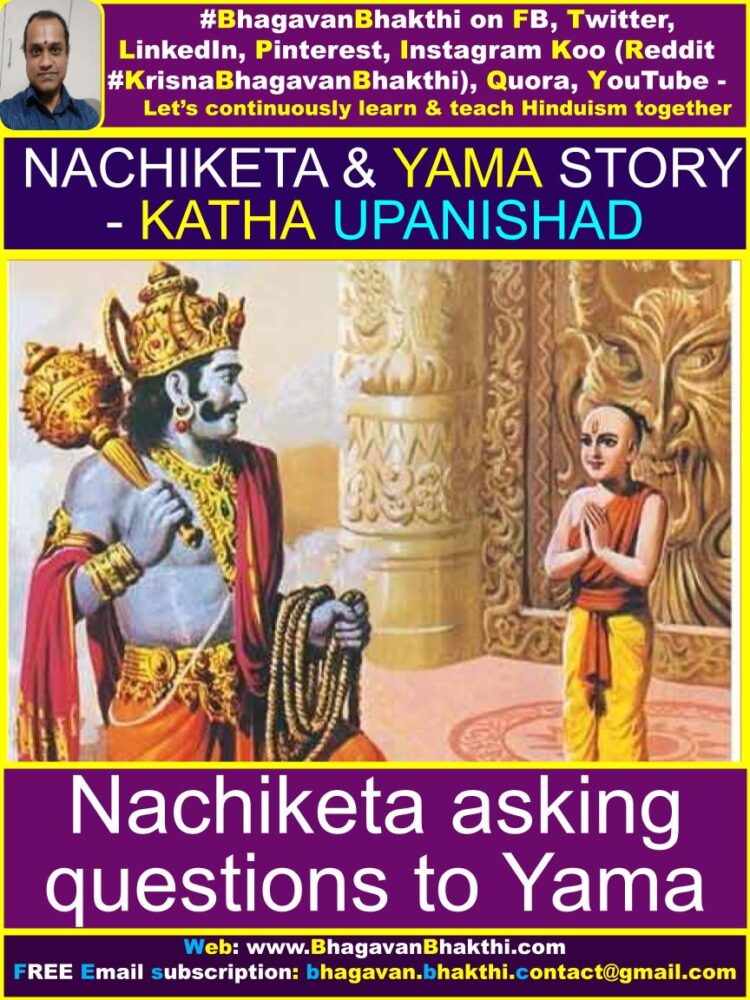
At the end of it, Lord Yama gave something special that Nachiketa couldn’t get here in this world and also in Swarga Loka (Heaven). It includes items like Kamadhenu, Kalpavriksha, Somapana etc.
Nachiketa, however, rejects all of them with the simple logic that hearing about eternal truths is fulfilled by unheard-of transient things. [Nachikeya says, he is sure to get all these ephemeral things because he sees a Brahman-jnaani (ब्रह्म ज्ञानी) like Lord Yama!]
Lord Yama is pleased and still reluctant to share the secret to Nachiketa. When Nachiketa appears determined, Lord Yama recognizes his potential for such knowledge and begins with a brief introduction to the Supreme Personality (Vishnu) who controls Moksha (liberation).
Lord Yama says that very few can attain this knowledge and it is surprising that only once such Guru and disciple meet to discuss this knowledge. It should not be understood by logic or any other method, but only by Guru Prasad (blessings of a Guru).
Then for the first time Lord Yama agrees that he knows the qualities of the Supreme Personality (Lord Sri Vishnu), someone who controls Moksha (liberation), and he (Yama) is capable of teaching it.
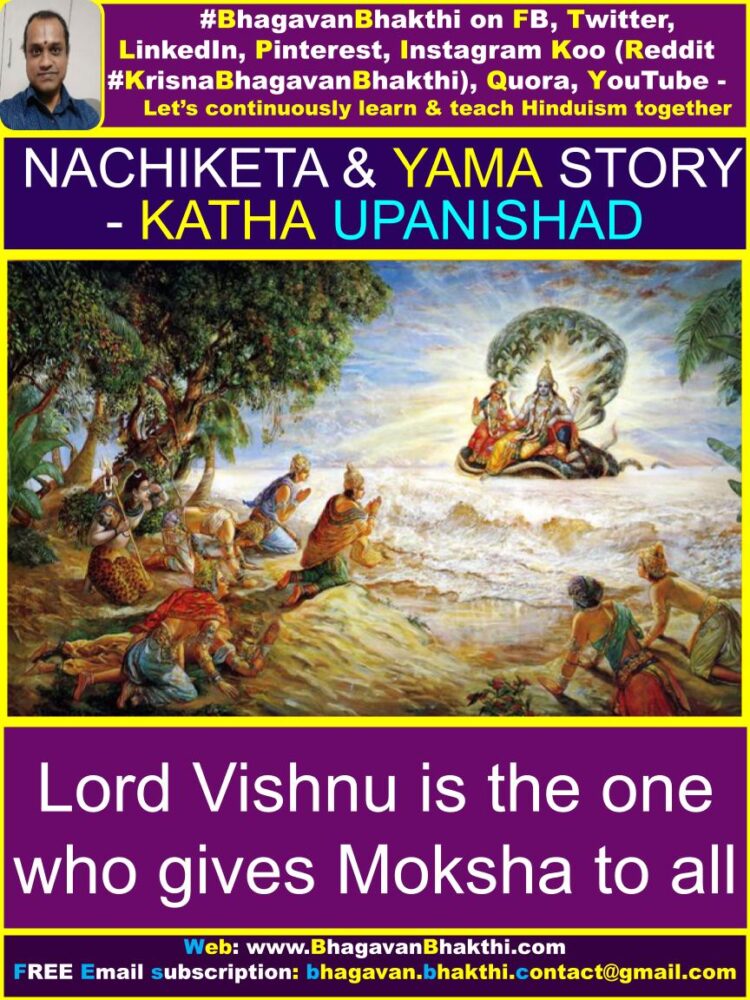
Qualities of the Supreme Personality (Vishnu) is as given below as mentioned in Katha Upanishad (as said by Yama to Nachiket):
The Supreme Personality (Vishnu) is spoken of by all the Vedas and is the object of all penance, towards which all knowers of Brahma Jnaanis (ब्रह्म ज्ञानी) move, and He (Vishnu) is in the form of the Pranava Mantra ‘Om’ (ॐ).
He (Vishnu) supports all and all should take His (Vishnu) support and knowing this can lead to Brahmaloka (Lord Brahma’s planet). Although He (Vishnu) resides in the bodies of all souls He (Vishnu) is unborn, eternal and unaffected.
He (Vishnu) is smaller than the smallest jada (matter) or jiva (being), within the smallest and greater than the largest, permeating even the universe – the largest. He (Vishnu) is present in all beings, in the ‘cave-called-heart’.
He is the force (energy) behind all activities of all living beings, yet unaffected by such activities and is to be realized only by His (Vishnu) prasadam (blessings). By sitting in one place, He (Vishnu) can reach great distances; If he sleeps in one place He (Vishnu) can roam anywhere and everywhere.
As the jiva (being) is within the body, so He (Vishnu) should be known to remain within the jiva. One cannot understand Him (Vishnu) by talking about Him (Vishnu), or by hearing many, or by the intellect alone, or by any other means, except by choosing Him (Vishnu) to understand Him (Vishnu). And it is He (Vishnu) who finally sets us free (Moksha).
He (Vishnu) has no defects, no unhappiness (always in blissfulness), and no disturbed mind and must be understood to the extent possible to attain liberation (Moksha). At the time of deluge, even Brahma and Vayu emerge as mere bite (food) and the God of death is mere pickle to him.
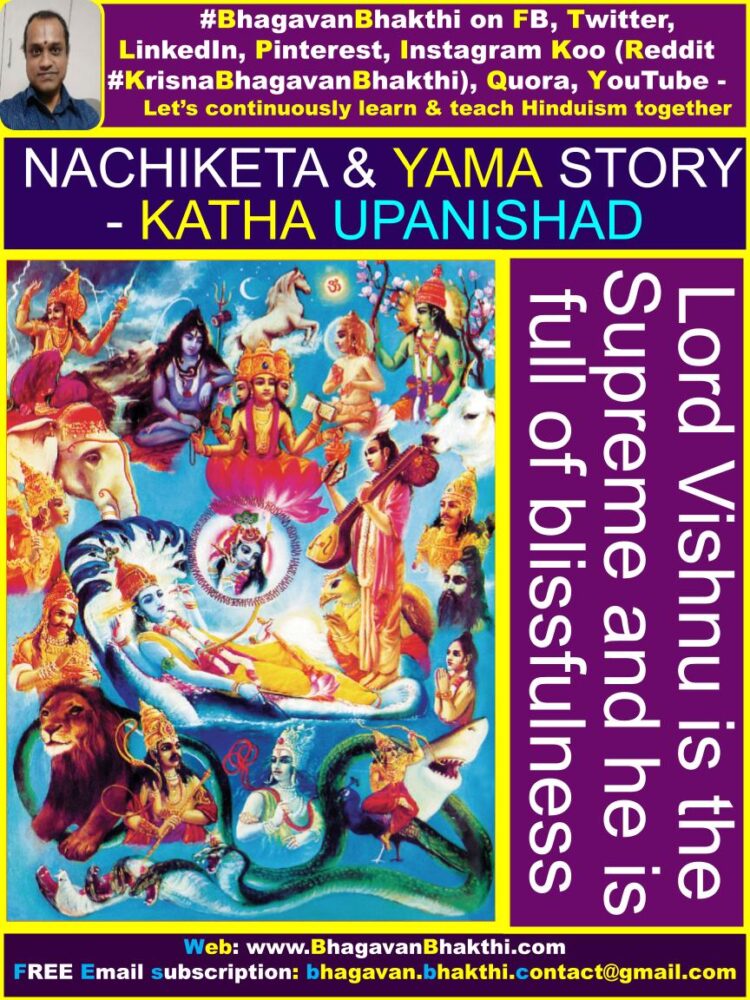
After briefly stating some of the qualities of the Supreme Personality (Vishnu), Lord Yama now teaches to Nachiketa the process of learning and realizing Him (Vishnu) as follows:
The body is the ratha (chariot) in which the jeeva (being) remains as the charioteer. His (Vishnu) buddhi or intellect is the driver (sarathi / charioteer) and His (Vishnu) manas (mind) is the controller. His (Vishnu) indriyas (senses) are horses and vishayas (subject) are paths.
These are the goals to reach the Supreme Personality (Vishnu) on whom everyone and anyone depends.
One who does not know these details and whose mind is not in the bosom of his intellect, and whose mind does not know where the goal is, will meet with an accident. On the other hand, one who knows the goal and uses horses and bridles well, attains his goal, that is, Lord Sri Vishnu.
Here the attention is specially invited to the word Vishnu used in the Katha Upanishad to denote the Supreme Personality (Vishnu) of Godhead (तद् विष्णोः परमं पदं / ತದ್ ವಿಷ್ಣೋಃ ಪರಮಂ ಪದಂ / tad viṣṇōḥ paramaṁ padaṁ).
The Katha Upanishad, apart from clearly pointing to Lord Sri Vishnu as the Supreme Personality, and to be taken as the goal to be attained by those who seek liberation (Moksha), makes another important basic rule of hierarchy as the means to attain it.
It specifies senses (indriyas), vishayas (subjects), manas (mind), buddhi (brain), atma (chit / soul), mahat, avyakta and purusha in ascending order, with the particular note that no one is equal or great than Purusha (Vishnu).

Most available commentaries on this Katha Upanishad list the above hierarchy and satisfy it by talking about the unconscious part of the function, referring to consciousness, super-consciousness, universal-consciousness and so on.
If we are to understand the power and life force behind these instruments, we must surrender not only to the Upanishads but also to its extensions such as itihasas (Hindu history) and Puranas.
All the demigods of karmendriyas (कर्मेन्द्रिय) and jnanendriyas (ज्ञानेन्द्रिय) are under the control of sensual Goddess Parvati. She adores her husband Rudra (Shiva), a mano-abhimani (mind controller). Lord Shesha and Lord Garuda are to be understood as equivalent to Lord Rudra (Shiva) in the qualities and likewise to their consorts.
All the above Gods and Goddesses in turn takes the orders of Goddess Saraswati and Goddess Bharati, the goddesses of wisdom. Lord Brahma and Vayu (the chit of our brain) which represent essence govern memory and in turn are governed by the unmanifested Goddess Ramaa Devi (Lakshmi).
Even Goddess Ramaa is subordinate to the ‘Purusha shabdha Vachya’ of Purusha Sukta, that is, the Supreme Lord Sri Vishnu, who has no equal or superior at any time, from aadi kalam (grand first time) until the ‘ananta kalam’ (grand infinite time).
The Katha Upanishad gives another important and fundamental concept of dependence of all souls on Him (Vishnu). For this a metaphor called ‘Bimba and Pratibimba’ (object and image / reflection) is used.

Between Jiva (being) and Paramatma (God / Vishnu), there are 16 other Bimbas and therefore Paramatma has to be seen through each of the intermediate Bimbas (image). This again follows the previously mentioned grade or hierarchy.
Another important point mentioned in the Katha Upanishads is that Antaratma (अन्तरात्मा) enters the Jiva’s (Being) body along with Prana (life) and leaves along with Prana (life). The ‘antaryami’ (अन्तर्यामी) Lord Sri Vishnu takes infinite forms to suit the uniqueness of each soul.
He (Vishnu) also exists in two ‘antaryami’ (अन्तर्यामी) forms – one within the body (देह / deha) and the second within the jiva (being). His (Vishnu) form is related by the Katha Upanishads to the size of a thumb. Apart from these infinite ‘antaryami’ (अन्तर्यामी) forms, He (Vishnu) has various avatar forms and root (moola) forms.
The Katha Upanishad suggests that there is no difference between these infinite and unique forms of Lord Sri Vishnu. The famous saying ‘Neha Nanasti Kinchana’ (नेहा नानास्ति किञ्चन) indicates this. This concept is the true ‘advaita-in-His-forms’ of the Vedas which is acceptable to Sri Madhvacharya Ji.
This cannot be misconstrued as Jiva-Brahma aikya (Being and Vishnu unity). Sri Madhvacharya Ji refers to Shabda-Nirnaya to establish the true meaning of Nehananasti. The Katha Upanishad says that one who does not understand God (Vishnu) as above is doomed to fall like raindrops on the top of a mountain.
To dispel the Jiva-Brahma aikya (Being-Vishnu unity), the Katha Upanishad clearly uses the term ‘Tadrugeva Bhavati’ (तादृगेव भवति) and not ‘Tadeva Bhavati’ (तदेव भवति), for example adding water to water.

Sri Madhvacharya Ji cites Bhavishya-Parva to explain this mantra in the words of Lord (Sage) Sri Vedavyasa, that is, clearly discarding aikya (unity) as understood in other schools of other Vedanta. Aikya (unity), means being together at best and never being the same (in quality).
Antaryami (अन्तर्यामी) is described as residing in the jeeva’s (Being) body with Ekadasa-dvaras (11 doors). Generally, the human body is mentioned in the scriptures as ‘nava-dvara-pura’ (नव-द्वार-पुरा) (place of nine doors) and here two more are added.
Guru Sri Raghavendra Swamy defines the additional two as Manas (mind) and Buddhi (brain). Guru Sri Vedesha Tirtha Ji adds another dimension by defining Nabhi (navel) and Brahmarandhra.
The famous Srimad Bhagavad Gita sloka, “Urdhwamoolam Adhas Shakham”, originally finds its place in this Katha Upanishad. The universe is symbolically spoken of as a huge tree, upside down. Lord Sri Narayana (Vishnu) is at the top and is the basis of the tree, like the ground support.
Goddess Ramaa Devi acts like the roots of a tree held underground. Brahma and other Devatas (Demigods) are branches. This tree is eternal like a flowing river. Branches, leaves and fruit keep falling and growing. But neither this fall nor growth affects the tree, which always remains still.
Out of the 101 prominent Naadis (नाडी) in the body, the Sushumna Naadi represents the royal path for the Jeeva (Being) to leave, when He (Vishnu) decides. One who leaves by the Sushumna Naadi and moves upwards, never returns to samsara (sansar) (on earth).
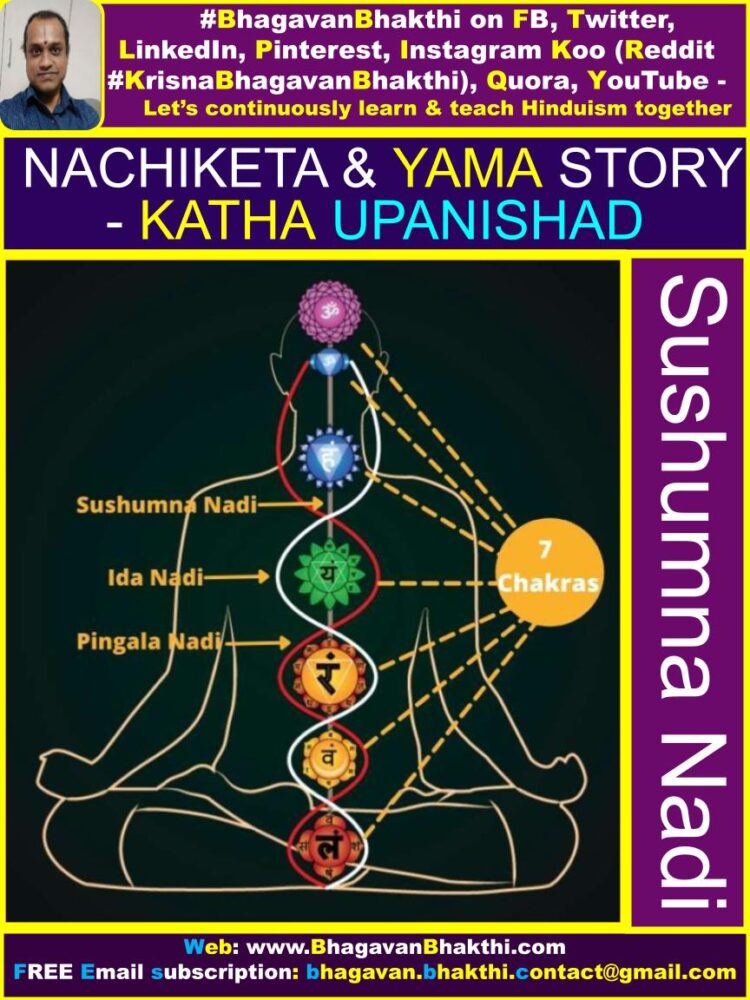
To achieve this, one should stay in our ‘heart-cave’ (Hrudaya Guha) and meditate continuously on the ‘angushta-matra-purusha’ (Vishnu in the thumb quantity form) as ‘jeeva Antaryami’ (God present inside Being).
Reflecting this in all our activities at all times can bring us the right knowledge and His (Vishnu) prasada (blessings), only (Vishnu) He can be reached step by step. This knowledge provided to Nachiket through ‘God of Death’ (Lord Yama) can bring us Vidya (knowledge), Medha (wisdom), Yoga and Vishnu Prasada (blessings).
Sri Madhvacharya Ji concludes by establishing that the purpose of this Katha Upanishad is to affirm Vishnu-Jiva Bheda (difference between Being and Vishnu) and Vishnu Sarvottama (Supremacy). Nachiketa bows to Lord Sri Vishnu, who is dear to him forever, in the cave called as ‘Hrudaya Guha’ (Heart cave).

More information about Nachiketa and Lord Yama story (conversation) (dialogue) is as given below (As per Puranas and Mahabharata):
Once, Janamejaya asked Sage Vaishampayana about Yamapuri (Yama Loka) and it’s location. He also wanted to know as to what should a man do so that he does not have to go there (Yama Loka).
Rishi Vaishampayana narrated the tale of Nachiketa, one of the few blessed persons to have visited Yamapuri (Yama Loka) with his mortal body. Long Long ago, there lived a Rishi / Sage named Uddalaka. He had a son named Nachiketa.
One day, while Uddyalaka was performing a ‘Yagya’ (Sacrifice), Nachiketa arrived there and disturbed him by repeatedly asking – ‘To whom will you give me?’
Sage Uddyalaka, in a fit of rage cursed Nachiketa to go to Naraka / Hell. But after he cooled down, he regretted for having cursed his dear son. Nachiketa being an obedient son was ready to go to Naraka / Hell also. His father tried his best to convince him against doing this, but to no avail.
Nachiketa assured his father that he would return safely after visiting Yamapuri (Yama Loka). Thus, Nachiketa went to Yama Loka and met Lord Yamaraja (Yama Deva), the Lord of death.

Nachiketa stayed in Yama Loka for some days and witnessed all the events taking place over there. Ultimately he sought Yamaraja’s (Yama Deva) permission to return. When Nachiketa returned home, his father Uddalaka was extremely delighted to find his son alive.
Very soon, the place was thronged by many people and everybody was curious to know about his experiences during his stay in the Yama Loka with Lord Yama Deva.
Nachiketa’s experience in Yama Loka is as given below:
Nachiketa replied: Sinners like liars, greedy people, jealous people, calumniators, treacherous people etc., go to Naraka / Hell. Similarly, One who kills a child or a woman, or kills a brahmin, or one who criticizes the Vedas,
or lends money for huge interest, or one who abandons his parents or faithful wife, or one who criticizes his Guru, or One who sells liquor, or a Brahmin (Brahmana) who sells Vedas (Hindu Texts), all these people goes to Naraka (Hell) and tastes the fruits of his sinful actions.
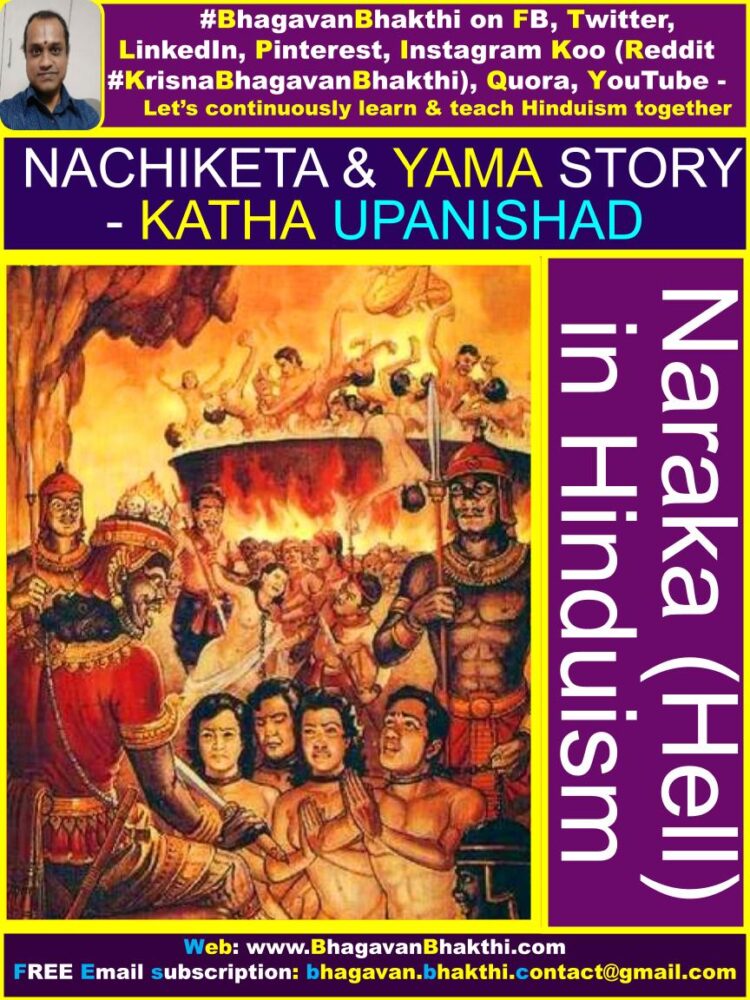
How Yama Loka looks (construction / Visual appearance) : Nachiketa continued, Yamapuri (Yama Loka) is made of gold and spread in the area of one thousand Yojanas. It is well fortified and it is impossible for anybody to trespass its territory.
Nachiketa continued, I saw sinners experiencing unbearable torture over there. I also saw couple of rivers flowing there like Pushpodaka river, at the bank of which there are trees in abundance and Vaivasvati river, which flows through the central part of Yamapuri (Yama Loka).
Nachiketa continued, Vaivaswati river contains divine water which never dries up. Yamapuri (Yama Loka) has two entrances, one through which only virtuous souls like Rishis / sages and hermits are allowed to enter and the second through which sinners enter Yamapuri (Yama Loka).
The former entrance is such that even heat loses its quality in its vicinity. The latter entrance is situated in the south and has a large iron gate. I (Nachiketa) also saw three large ditches called ‘Audoombara’, ‘Avirchimana’ and ‘Uchchavacha’ which are meant for the sinners.
Sinners are also forced to pass through the flames that continuously keep on erupting to the west of Yamapuri (Yama Loka). I (Nachiketa) saw a grand assembly hall, where truthful and virtuous people live.

This grand assembly hall is graced by the presence of Rishis / sages like Manu, Vyasa, Atri, Gautama, Angira, Bhrigu and others. There, I (Nachiketa) saw a Goddess who is worshipped by Yamaraja (Lord Sri Yama Deva). The Goddess controls all the functions of the world.
I (Nachiketa) also saw the ferocious Kala. He possesses extreme anger and is very powerful. Time does not have any influence on him as the result of which he enjoys eternal youth. I (Nachiketa) also saw various types of demons and giants in the Naraka (Hell).
I (Nachiketa) saw many messengers of Yamaraja (Lord Sri Yama Deva) punishing the sinners. Some were beating the sinners with sticks in their hands, while some sinners were being forced to enter fire.
I (Nachiketa) saw all the sinner wailing and repenting for their sinful deeds. Many sinners were kept at a very dark place, where there was no light. Those who had committed graver sins were put in boiling oil.
I (Nachiketa) saw many sinners being given all sorts of severe punishment. I (Nachiketa) saw a place where iron nails were spread all around. This was the place where people who breached the modesty of women were given punishment.
I (Nachiketa) saw ten different Narakas (Hells): Tapta, Mahatapta, Raurava, etc. – Each of the latter is more ferocious than the former. The sinners are sent to all these Narakas (Hells) on the basis of the gravity of their sins.

Yamaraj (Lord Sri Yama Deva) himself instructs Chitragupta (Lord Sri Yama Deva’s minister) on the punishment to be given to these sinners.
KARMA VIPAKA: Karma Vipaka means the fruits one reaps according to his or her Karma. While continuing with the description of various aspects of Naraka / Hell, Nachiketa told the assembled sages that:
At Yamapuri (Yama Loka), Chitragupta goes through the record of all the deeds, committed by a man when he / she was alive and brings into the notice of Yamaraja (Lord Yama). Yamaraja then decides upon the punishment to be given to the concerned soul.
The punishment can be varied like if the soul was virtuous, then it would be sent to Swarga Loka (Heaven), or the soul may even be made to take birth as a tree, or an animal or any other creature.
Sinners like those who had remained disinclined towards any kind of virtuous deed, or those who had abandoned there faithful wives, were sent to the Naraka (Hell) named Raurava Naraka.
The souls of virtuous people were sent to the Swarga Loka (Heaven). Those who had extreme attachment (bondage) to women took rebirth as human beings. People who had attained martyrdom while fighting a battle, were sent to Indrapuri (Indra Loka) (Swarga Loka).
Those who had engaged themselves in virtuous deeds throughout their lives were rewarded for their good deeds as per their good Karmas.

VIRTUES OF CHASTITY: First of all, the area is purified by coating it with cow-dung after which a black deer-skin is spread on it along with ‘kusha grass’. Two pots-one large and the other a small one are placed side by side.
These pots are filled with sugarcane juice and symbolize ‘Rasa-Dhenu’ and the calf. Four sugarcanes symbolizing the four legs of ‘Rasa-Dhenu’ are fixed at four corners. After that, one small silver piece is placed at the base of each of the sugarcanes symbolizing hoofs.
Rasa-Dhenu is then adorned with colorful cloths and flowers. Again, four small pots filled with sesame seeds are kept at the four corners near Rasa-Dhenu. After the worship is accomplished, Rasa-Dhenu is donated to a virtuous brahmins.
A person who donates Rasa-Dhenu is liberated from all his sins and all his ancestors as well as the generations to come attain to the Swarga Loka (Heaven).
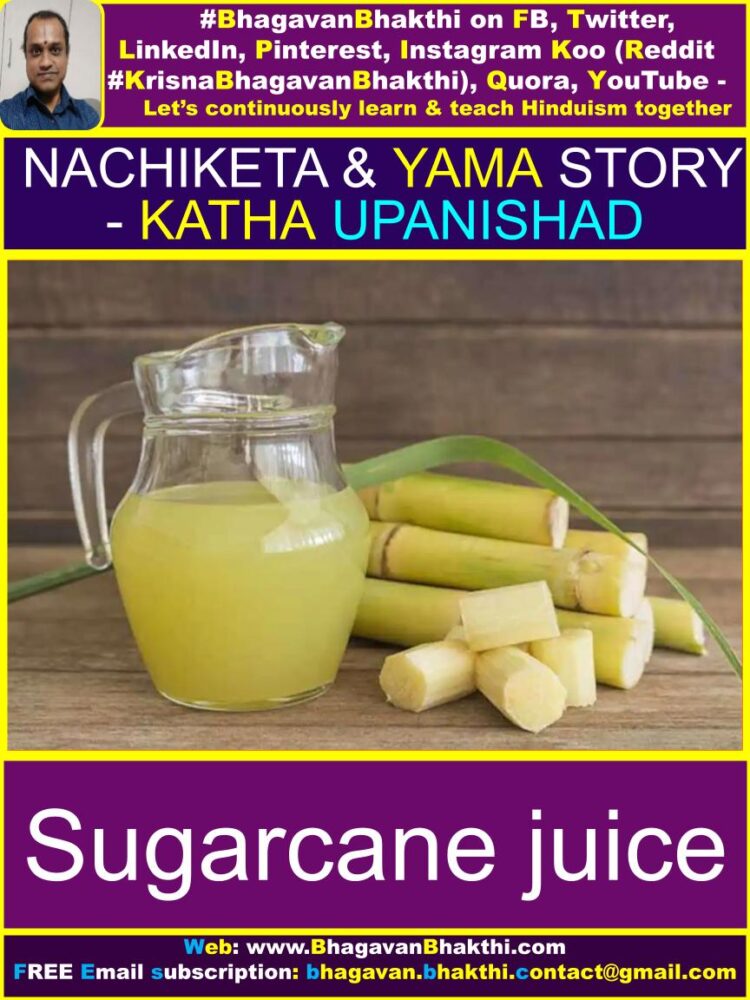
LIBERATION FROM SINS: Once Devarshi Narada asked Yamaraja (Lord Yama) about the reason why joy was so elusive to human beings. He also wanted to know about the reasons for man’s sorrows.
Yamaraja (Lord Yama) replied: Man’s destiny is defined by his own actions (good and bad Karmas). He has to taste the fruits of his actions. He has to taste the fruits of his each and every actions.
So, when a man finds himself amidst sorrows, he must realize that he is reaping the fruits of his past actions (Bad Karmas). If a man commits virtuous deeds, then joy is experienced, but sinful deeds invite sorrows and miseries.
Desires force a man to take countless birth. A man takes birth on the basis of his past Karmas. Lord Sri Vishnu (God) does not interfere in this matter. So, only foolish people curse Lord Sri Vishnu (God) for their miseries. They forget that their sorrows are of their own making.
A man can liberate himself from sins by engaging in virtuous deeds and abstaining from sinful works. A man should perform his duties with a sense of detachment, because attachment results into the transmigration of the soul.
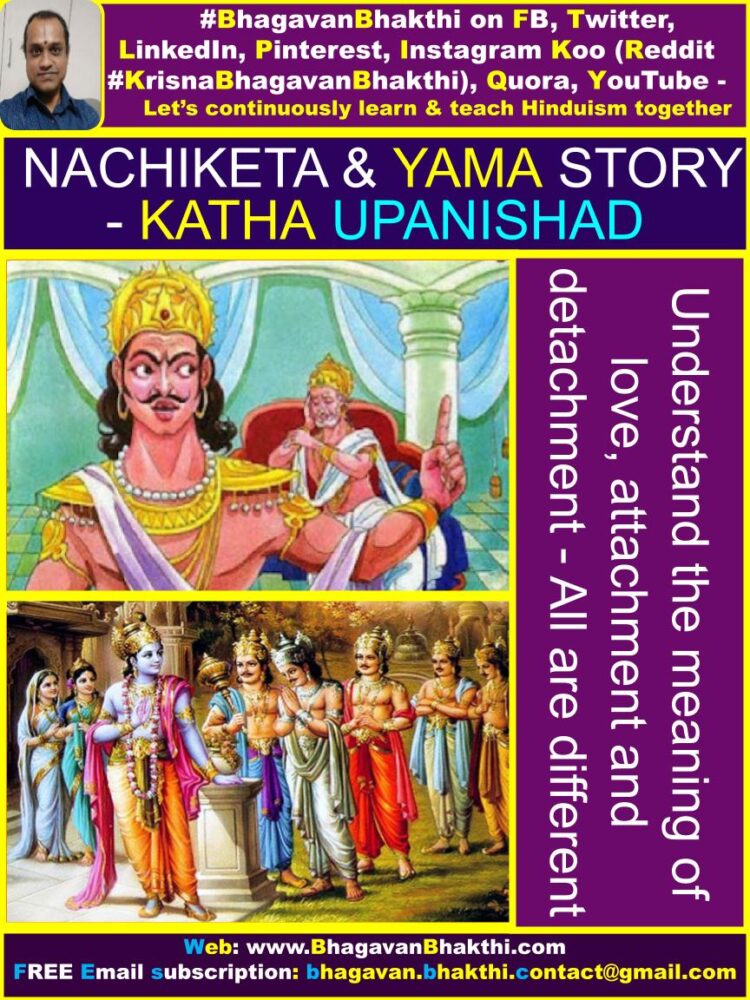
(Note : Here detachment means, someone can love his / her children, wife, husband, parents etc. But that love should not be converted into foolish attachment. For example the foolish attachment between Dhritarashtra and Duryodhana.)
(If a child makes a mistake, then that child must realize his / her mistake and should be able to correct it at the earliest. This realization should be provided by the elders like parents, grandparents etc. Duryodhana never followed Lord Sri Krishna and Dharma.)
(Similarly, detachment doesn’t mean you should be away from your children and others. For example, Pandavas. Pandavas always loved each other. If someone was making a mistake, elders would try to correct that mistake. They always followed Lord Sri Krishna and Dharma.)
Let’s continue with our story – Lord Sri Brahma Deva has declared that ‘Shishumara chakra’ is the symbolic expression of his own self. Anybody desirous of getting liberated from his sins must make an image of this chakra and worship it.

One who visualizes this chakra within his body, too, becomes liberated from his sins. Mental worship of various planets (Jupiter, Venus, Mercury, Saturn, Mars etc.) visualized at the various points of this chakra helps a man to become liberated from all the sins.
Similarly, practicing Pranayama for hundred times helps a man to become liberated from all the sins. The most easiest way to become liberated from sins is by engaging oneself in the servitude of a Gau-Maata (Mother Cow). This deed is as virtuous as making pilgrimages to all the sacred places together.
Observing fast on Ekadashi also helps a man to become liberated from his sins. Having finished his narrations, Nachiketa, looked at the sages, who were listening with rapt attention.
When asked about on how to avoid going to Yama loka or Naraka, Nachiketa replies, “The naama smaranam (Chanting the names) of Bhagavan Lord Sri Vishnu (Krishna) is the only way”.
The sages thanked Nachiketa for enlightening them on the sacred place called Yamapuri (Yama Loka).
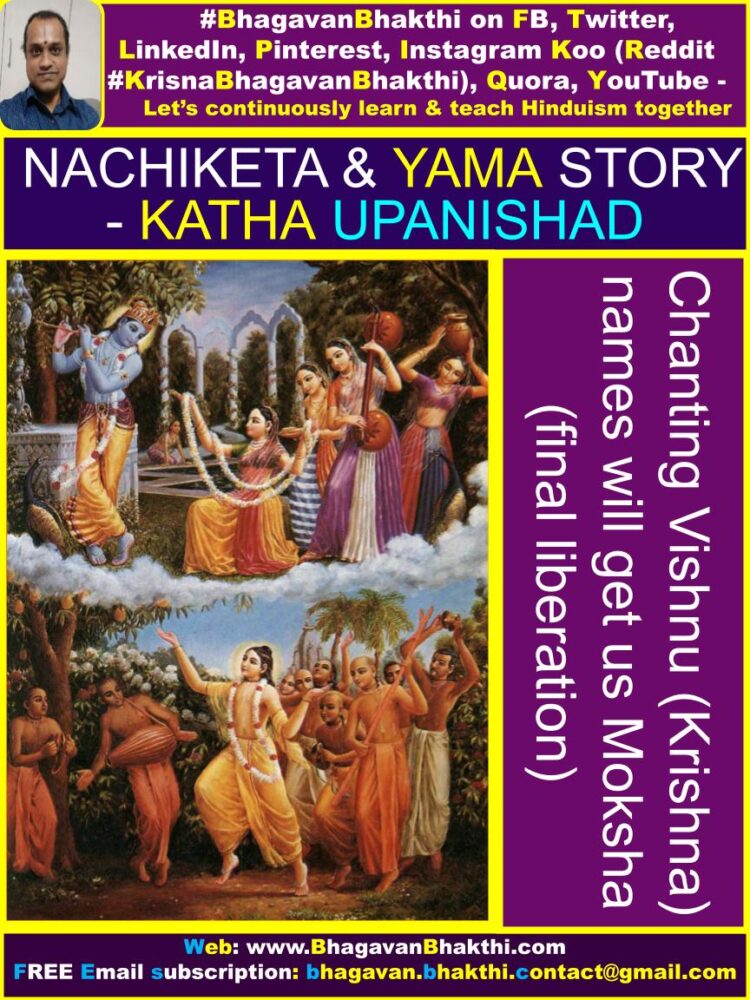
More information will be added to his post (article) on regular basis. Please visit again to know the updated information after some time.
Let’s know more info about Hinduism (Sanatana Dharma) and Bhagavan Lord Sri Krishna (Vishnu) by clicking the below link:
Naraka information as per Hinduism
Hinduism (Sanatana Dharma) information, facts, etc.
Lord Sri Vishnu stories, information, facts, significances, etc.
About Bhagavan Lord Sri Krishna
List of demons killed by Lord Krishna
Continue reading about Hinduism (Sanatana Dharma) :
Rivers information in Hinduism (Sanatana Dharma)
Mahabharata information, facts, significance, importance etc.
Ramayana information, facts, significance, importance, etc.
To watch, “When was Hinduism (Sanatana Dharma) was started“, please click the below YouTube video link:
To watch videos on #Hinduism #Sanskrit language, SUBSCRIBE to my YouTube channel from this below link:
#BhagavanBhakthi YouTube channel
Dear friends, if you need any clarifications about this post, kindly let me know, I will definitely try to answer all of them.
Also your one LIKE, one COMMENT, One Share, one SUBSCRIPTION is highly important.
This will help to know the quality of this content and also it will be helpful to know if any improvements is required for the content.
If you feel this content is useful to you and has helped you to improve your knowledge, kindly share this with your well-wishers.
Because “SHARING MEANS CARING”.
For receive FREE EMAIL SUBSCRIPTION about #BhagavanBhakthi, you can send an email to [email protected] from your email ID.
NAMASTE!
SRI GURUBHYO NAMAHA
OM NAMO NARAYANAYA
Sri Krishnaarpanamastu
Share in Social Media